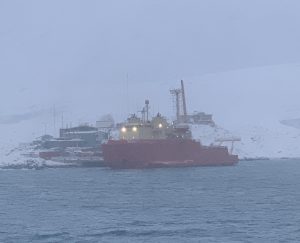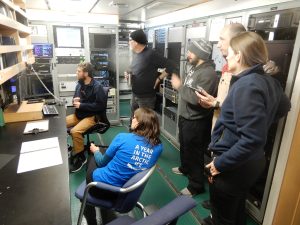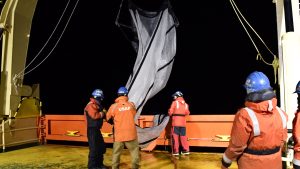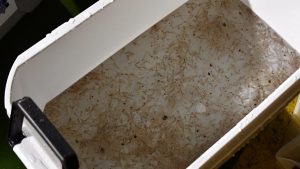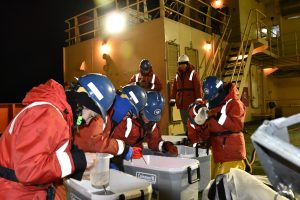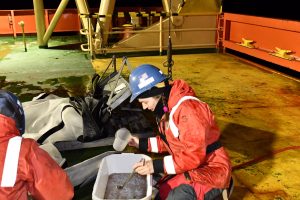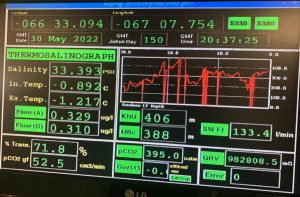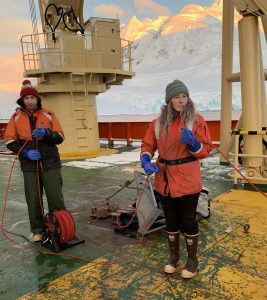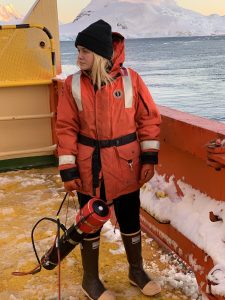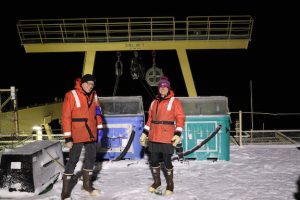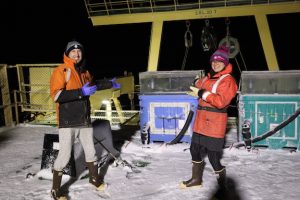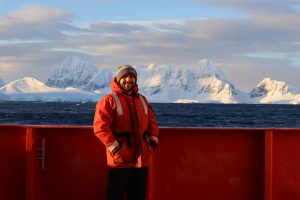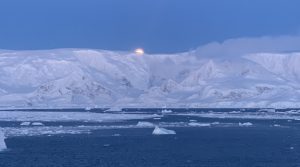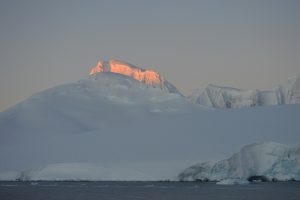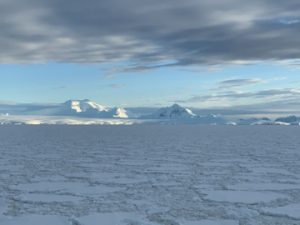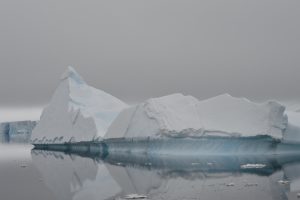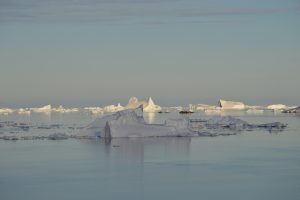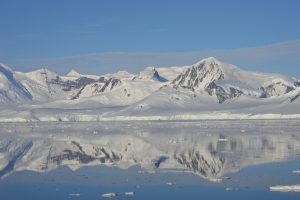1. Blog and Images from a May/June/July 2022 research expedition west of the Antarctic peninsula aboard the Nathaniel B. Palmer.
This series will be from the beginning of our expedition during times of Covid. Some info and pictures from earlier expeditions can be found beneath this current blog. We were supposed to return to Antarctica in 2020 and 2021, but the trips were cancelled due to the epidemic. We have finally gotten the opportunity to return, but there are many precautions to keep covid from reaching the U.S. bases in Antarctica. These begin with a stateside quarantine in a hotel followed by a 2-week quarantine in Chile before we reach the Nathaniel B. Palmer. I kept a log during quarantines and have cut & pasted bits here. I’ll try to update every few days once we depart. Support for our work in Antarctica was supplied by National Science Foundation grants ANT 1744767 to Robert Sanders, ANT 1744663 to Rebecca Gast and ANT 1744638 to Wade Jeffrey. Opinions and conclusions expressed in this blog are those of the author and do not necessarily reflect the views of the National Science Foundation.
There are three science teams on board the USIB Nathanial B. Palmer ((That’s United Stated Ice Breaker). One team is investigating krill biology and is led by Kim Bernard. A second team learnin about seals in lead by Luis Huckstadt. Our team consists of myself (Principle Investigator), Becky Gast (co-PI, Woods Hole Oceanographic Institution), Jay Diii Grattepanche (researcher, Asst. Professor, Temple University), Chris Carnivale (grad student, Temple Univ; Leila Harris (grad student, U. West Florida); Liz Everett (student, UWF).
April 26 – Tuesday – I took Uber to airport for an 8:30 am flight to San Francisco where we started our Covid quarantine. We will spend 3 days in San Francisco at the SFO airport hotel. My room is on 5th floor – just below the height where the airport terminal train arrives. I don’t hear the train, but it blocks sunlight every 6 minutes when it goes by. The hotel is relatively new. My room has two queen beds, a small desk, large bathroom. Food is delivered to the door in bags. Room comfortable food is good.
April 27 – Wednesday – Spent time working on a manuscript, but also answering emails as department chair … but letting vice-chair, Erik Cordes, handle most of the big stuff. Also, several Zoom “training sessions” that have applied mostly to people over-wintering at Palmer Station rather than those staying on the ship. We will be dropping people off to overwinter and bringing other people back after we finish our sampling in June.
April 28 – Thursday – Out of room for first time for … a covid test! We stand in line, socially distanced with masks on and then immediately back to the room.
April 29 – Friday – Bus to airport in Oakland. Take chartered jet overnight to Chile. People spread out over plane – alternating rows between window sections and the middle section, with one person per row of 3-4 seats. Arrived in Punta Arenas, Chile on Saturday mid-morning.
April 30 – Saturday – After going through customs, we were split up into two buses for a 3-hr ride to Puerto Natales where we stayed split at different hotels. One was for people boarding the L.M. Gould who mostly were overwintering at Palmer Station. Those in our hotel are to board the Nathanial B. Palmer for the oceanographic expedition. We have a couple of people (Kim Bernard’s team) who are overwintering, but first they will capture krill that they are going to take to Palmer Station to use in experiments over the winter. We are in Hotel Borde Glacial – three-story hotel. First floor dining and bar (which we don’t use) because, as before, we eat and drink in our rooms. Two floors of 14 rooms per floor that all face the water. A small area near the stairway with coffee and tea. My room is third floor near middle. All of the rooms have a picture window and one that can be opened that overlook the ocean inlet (land on the other side) from which we can see snow-capped mountains across the water in front of us and to the right (west, sunset). To the east we can see the town (where the other hotel is located). There are 23 in our group of scientists and science support people. Food still delivered to our doors where we eat alone. But we do have more freedom in that we are allowed to walk outside from 9-11 am and 1-6 pm.
May 1 – Sunday – First breakfast – a bowl of fruit, some oats and small container of yoghurt, sliced ham and cheese an egg and 3 slices of bread (this repeats). We are 1 hour ahead of EDT in this part of Chile – so this will remain out time zone during the cruise as well. Confined to our rooms from 11am-1pm, but otherwise can go to the landing and get coffee, tea, water, but cannot move about in hotel. We were able to walk outside today. In the morning I walked down the steep hill to the water and was met part-way down by large and friendly dogs (someone named them Chile dogs). A rocky beach. Black-necked swans, gulls, some brown ducks with a bluish patch. I tried to find a good guide to birds of Patagonia but was not able to identify (except swans). Back to the room until lunch. Then a walk in a hilly meadow to the west of the hotel. It is surrounded by barbed wire and quite steep in places, but it has some trails created by previous walkers – mostly tramped-down grass. Many bushes with long thorns and lichen.
May 2 – Monday – Very heavy rain last night and strong winds; rain has generally stopped, but wind blowing hard. Temperatures in the forties (F). Had our first covid test in Chile – a deep-nasal test. I think everyone teared up! A couple of rainbows during the day, including a double one. One end seemed like it ended in the water directly in front of the hotel.
May 3 – Tuesday – All covid tests negative at our hotel, but one positive at the other, so we have another Covid test on Friday.. Another couple of rainbows. Dinner was roasted guanaco, which is related to llamas, but wild. Didn’t know what I was eating and thought it was beef.
May 4 – Wednesday – Quarantine is boring. My internet has been okay so I can still do some email work (and leave as much as possible for Erik as departmental vice-chair). Can even get Netflix in evenings. But staying in a small room with some outside time twice a day got old fast. Food is still generally good and can order cocktails.
May 5/6 – Thursday/Friday – First week in Chile is in the past, mostly same old, same old. Our next covid test was today. I’d be surprised if anyone is positive till never see anyone without a mask- indoors or out. So not conducive to meeting new colleagues. It’s been really windy (the building creaks and my window whistles) and also heavy rain, but rain was mostly at night. I’ve managed to walk each day but have generally stuck to the steep gravel drive since the trails through fields are so muddy. Food has included lots of creamy dishes. Last night was eggplant pudding. We’ve had several training sessions on Zoom – harassment, alcohol, etc. and I’ve had a couple of zooms at Temple, but internet is spotty midday when everyone is using it. Written a couple of reference letters and reviewed a really looong manuscript about rotifers for Limnology & Oceanography. So still feel very much at work.
May 7/8 – Saturday & Sunday – Work in Chile closes down on weekends and it’s the 100-year anniversary of the origin of Puerto Natales. But somehow, on Sunday (Happy Mother’s Day!) we got results and everyone is negative for Covid. A sunny Sunday but very windy again.
May 9/10 – Monday/Tuesday – Same old, same old again
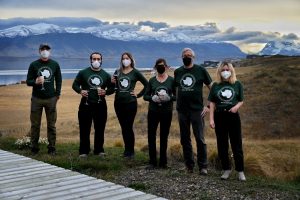 May 11/12 – Wednesday/Thursday – It was still sunny at 5 pm on Wednesday, so the mixotrophy team had a masked cocktail meeting outdoors. The idea caught on and several other scientists joined us. All spaced out & masked Back in our rooms by 6 to wait for dinner. On Thursday we had our 4th (and deepest) double nasal covid swab since going into quarantine.
May 11/12 – Wednesday/Thursday – It was still sunny at 5 pm on Wednesday, so the mixotrophy team had a masked cocktail meeting outdoors. The idea caught on and several other scientists joined us. All spaced out & masked Back in our rooms by 6 to wait for dinner. On Thursday we had our 4th (and deepest) double nasal covid swab since going into quarantine.
May 13 – Friday – Another slow day – packed up suitcases for the bus trip on Saturday. We had another 5-6 pm Happy Hour before retreating to our rooms.
May 14 – Saturday – Everyone tested negative. We loaded up on two buses and headed to the ship. The long bus ride seemed much more interesting after 2 weeks in quarantine and a good night’s rest instead of an overnight plane ride to get to Puerto Navales. Saw ostrich-like birds in the fields and condors above. The low trees were all wind-blown. Arrived at the dock and had to wait beside the bus before we could pull up near the ship and carry our luggage up the gangway. Got to the Senior Scientist cabin. It looks the same as in 2019 – down to the coverlet on the bed. Had fried chicken for dinner. Headed to an orientation which lasted about an hour. My email with be sanderbo@nbp.usap.gov. We probably depart Chile on Thursday. The ship has been in dry dock and most of the science gear was removed. It will have to be brought aboard before we can begin lab setup.
May 15 – Sunday – the Laurence M. Gould departs for Palmer Station. We are still waiting for supplies and equipment to come aboard. The photo shows the Gould baking off the dock with the shadow of our ship on its side.
May 16 – Monday – The internet on the ship has been slower than I remember. It seems that a part of the network connection failed, but parts have been ordered. In any event, some of our equipment arrived late yesterday and we started setting up today. Still wearing masks except when eating, which will continue until we leave port and the Chilean pilot leaves the ship. Food has been good, and we have access to the galley throughout the day for snacks.
May 17 – Tuesday – A better internet day. But still not much more to write about. Waiting on a bunch of equipment, but we were able to organize and put away some of our supplies in drawers and cabinets. This is mostly stuff that we left here in a warehouse during our last Antarctic trip two years ago. We expected to come back in April 2020, then April 2021, but were postponed by the pandemic. Had another Covid test from the Chileans this morning. Only one nostril but deepest plunge yet. The good news is that the different science groups have been able to interact with each other more. As I noted earlier, our masks come off during dinner, but we are eating each meal in ½ hour shifts so that there is a seat (or the table) between each of us. We still need to wear masks everywhere else on the ship except in our cabins. Only two pairs of scientists have roommates and everyone else is in a single room. Last night the marine technicians set up a ping pong table in the helicopter hanger which was entertaining. BTW there hasn’t been a helicopter on board ever when I was – probably not for many years.
May 18 – Wednesday – 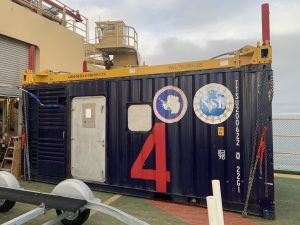 Something on my computer seems to be automatically updating and using up my allotment of time/MB of download/upload access every day. I can’t log on to use the internet after that happens. Very frustrated! More cargo has been coming aboard and we have been able to set up major parts of the lab. The radiation van (photo on right) came aboard, but before we can move into it, the electricity must be hooked up and the Marine Lab Tech has to do swipes of the inside to make sure there is no radiation from its last use. All radioactive work is done away from the main part of the ship in vans that are lifted off the ship when not used. That is a big set-up ahead of us, but Leila and Liz are night people, so if the swipes get done, they have the night to set up it up before we can leave and we’re supposed to leave at 1300 (1pm) tomorrow!! Tired since I didn’t sleep well last night, so am headed to bed early. I’ll try to write more about how we use carbon-14 and tritium to measure photosynthetic and bacterial production of new biomass later.
Something on my computer seems to be automatically updating and using up my allotment of time/MB of download/upload access every day. I can’t log on to use the internet after that happens. Very frustrated! More cargo has been coming aboard and we have been able to set up major parts of the lab. The radiation van (photo on right) came aboard, but before we can move into it, the electricity must be hooked up and the Marine Lab Tech has to do swipes of the inside to make sure there is no radiation from its last use. All radioactive work is done away from the main part of the ship in vans that are lifted off the ship when not used. That is a big set-up ahead of us, but Leila and Liz are night people, so if the swipes get done, they have the night to set up it up before we can leave and we’re supposed to leave at 1300 (1pm) tomorrow!! Tired since I didn’t sleep well last night, so am headed to bed early. I’ll try to write more about how we use carbon-14 and tritium to measure photosynthetic and bacterial production of new biomass later.
May 19 – Thursday – Almost everything that we need is finally on board, which is good as we are supposed to leave at 1pm today. We have tied everything down in the lab with rope, straps or bungee. Centrifuges, filtering towers, a flow cytometer, etc., so we are ready to go. Seems the same for the other groups.
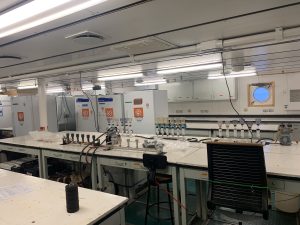 To the left is a photo of our lab set up. Much of what we do is filtering, which is why you see all the filtering towers on the benches. We filter water on to various filter types separately to get chlorophyll concentration (which is a proxy for phytoplankton biomass), bacterial DNA, and protist (algae and protozoa) DNA. The DNA can tell us the species present and we can determine diversity. All of the processing of this takes place elsewhere on the ship or the filters are frozen at -80°C for processing the DNA at home. Those are freezers for our samples and the other scientists samples to the left in the photo. 16:00 (4pm) – just got news that NSF is concerned that the liquid nitrogen maker is not completely set up. This takes several 12-h periods to get to the stage of making liquid N2 and is only partly done. They are also looking to find liquid nitrogen that also has already been made on shore that they can transfer into dewers, so we are going to delay. Both other teams want liquid nitrogen for quick freezing, so currently looking at departure at 13:00 (1 pm) tomorrow.
To the left is a photo of our lab set up. Much of what we do is filtering, which is why you see all the filtering towers on the benches. We filter water on to various filter types separately to get chlorophyll concentration (which is a proxy for phytoplankton biomass), bacterial DNA, and protist (algae and protozoa) DNA. The DNA can tell us the species present and we can determine diversity. All of the processing of this takes place elsewhere on the ship or the filters are frozen at -80°C for processing the DNA at home. Those are freezers for our samples and the other scientists samples to the left in the photo. 16:00 (4pm) – just got news that NSF is concerned that the liquid nitrogen maker is not completely set up. This takes several 12-h periods to get to the stage of making liquid N2 and is only partly done. They are also looking to find liquid nitrogen that also has already been made on shore that they can transfer into dewers, so we are going to delay. Both other teams want liquid nitrogen for quick freezing, so currently looking at departure at 13:00 (1 pm) tomorrow.
May 20 – Friday – We were still waiting for liquid nitrogen, at our first estimated time of departure (13:00), plus the marine technicians (MTs) are still securing some equipment that normally would already have been on board but was offloaded before the ship went to dry dock. Departure was delayed until 17:00 (5 pm). The views are supposed to be spectacular leaving toward the west and it was getting dark soon after we left, so we missed the scenery. It was cloudy/foggy anyway, so we wouldn’t have seen much.
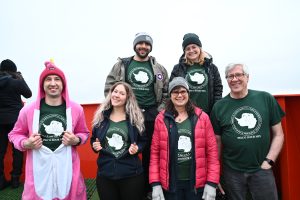 We did manage to get a team photo on the bow of the ship. Jay Diii is in a unicorn costume because on his first trip across the Drake, several scientists wore them for luck to get (relatively) calm seas across the Drake Passage, which is known to have some of the worst in the world. From left front: JayDiii, Leila, Becky, Bob; back – Chris, Liz. I went to bed about 9 pm and read for a bit before sleeping.
We did manage to get a team photo on the bow of the ship. Jay Diii is in a unicorn costume because on his first trip across the Drake, several scientists wore them for luck to get (relatively) calm seas across the Drake Passage, which is known to have some of the worst in the world. From left front: JayDiii, Leila, Becky, Bob; back – Chris, Liz. I went to bed about 9 pm and read for a bit before sleeping.
May 21 – Saturday – I didn’t even notice that we were underway in bed during the night but noticed a roll bow to stern when I awoke. Down for breakfast and most of science crew there. Not only are our masks gone now, but we all have the full hour together at each mealtime. They served bagels, cream cheese and smoked salmon (plus the usual eggs/bacon) for breakfast – I was happy! We lost several of the science party to their bunks by lunchtime as the rolls of the ship increased. A few people also learned not to leave books, drinks etc. unsecured on the benches after we had some slow but steep rolls. As Chief Scientist, I had several science planning meetings – with the captain, with B-303 (that’s our team) and with the principal investigators (PIs) of the three science groups that took up much of the day.
May 22 – Sunday – Woke up a lot last night. The ship was rolling side-to-side as we moved forward, which moved me in the bunk head-to-foot. The drawer beside my bed kept opening and slamming shut but a bit of duct tape fixed that. Got up at 7 am anyway and read the reduced NYT available through ship’s intranet. Breakfast, NYT crossword, then to work on a manuscript. There won’t be anything we can do science-wise until we are out of the Drake, so a couple more quarantine-like days. If we keep the same ship speed (~10 knots), we will reach Palmer station at about 7 pm on Tuesday. That will be too late for the stations doctor to come give Covid tests to the people that will overwinter or go ashore temporarily, so we will probably sit on site, and our team will take our first samples with the CTD after breakfast on Wednesday morning. I explain the Conductance Temperature Depth (CTD) apparatus in a future post.
May 23 – Monday – We are still transiting the Drake Passage, but we have had reasonable weather and the swells are generally not bad. That is not to say that the people that are more sensitive to sea sickness are happy. There a several whom we haven’t seen much outside of their cabins. Somebody always checks on them a couple of times a day.
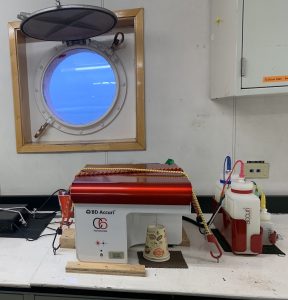 Since it’s a bit of a slow day, I thought I’d write about an instrument that we’ll be using during the cruise – a flow cytometer (FCM). The one we have on board (the red-topped instrument to the right under the porthole) is a smallish one – when I first used one in graduate school, they were the size of a small room. The basics of flow cytometry are for cells to pass in single file (in a very narrow stream of fluid) in front of a laser so they can be detected, counted, and sorted. Cells or cell components (e.g., the nucleus) can be fluorescently labelled before loading and then excited as they pass by the laser to emit light at varying wavelengths. In addition to detecting information from the fluorescence of each cell, the way that the cell scatters light gives information about its size, so that each cell can be identified by size and whether they are stained, or are naturally fluorescent, or not. The stream of water can then be deflected so that single cells with previously selected properties of size and fluorescence can be sorted away from the stream of fluid and collected for further analyses. FCMs are used in medical research for just counting or sorting – for example, separating different types of blood cells from the plasma. We use them to count and sort bacteria, phytoplankton (these have chlorophyll which is naturally fluorescent) and “protozoa”. We also examine these microorganisms with traditional and epifluorescence and light microscopy, but the FCM can separate either preserved or living cells.
Since it’s a bit of a slow day, I thought I’d write about an instrument that we’ll be using during the cruise – a flow cytometer (FCM). The one we have on board (the red-topped instrument to the right under the porthole) is a smallish one – when I first used one in graduate school, they were the size of a small room. The basics of flow cytometry are for cells to pass in single file (in a very narrow stream of fluid) in front of a laser so they can be detected, counted, and sorted. Cells or cell components (e.g., the nucleus) can be fluorescently labelled before loading and then excited as they pass by the laser to emit light at varying wavelengths. In addition to detecting information from the fluorescence of each cell, the way that the cell scatters light gives information about its size, so that each cell can be identified by size and whether they are stained, or are naturally fluorescent, or not. The stream of water can then be deflected so that single cells with previously selected properties of size and fluorescence can be sorted away from the stream of fluid and collected for further analyses. FCMs are used in medical research for just counting or sorting – for example, separating different types of blood cells from the plasma. We use them to count and sort bacteria, phytoplankton (these have chlorophyll which is naturally fluorescent) and “protozoa”. We also examine these microorganisms with traditional and epifluorescence and light microscopy, but the FCM can separate either preserved or living cells.
May 24 – Tuesday – We are still transiting the Drake Passage, still with reasonable weather. We prepared to take samples tomorrow – labeling bottles, acid rinsing glassware and plasticware to clean and/or remove trace DNA. We collect DNA samples and it’s easier not to have any background on our collecting/filtering equipment. Worked on our computers much of the day. I’m trying to finish up comments on a manuscript for which I am a co-author.
May 25 – Wednesday – Over night we arrived in the area of Palmer Station, and we planned to take samples using the CTD right after breakfast. In the meantime, JayDiii, Becky and I were in the lab doing last minute things to be ready. I mentioned that our cruise moniker is PISCO SOUR MIX (Phytoplankton Investigations in the Southern Coastal Ocean: Studies Of Unicellular Rates of MIXotrophy), and we are naming the stations after it to differentiate from our earlier expeditions in 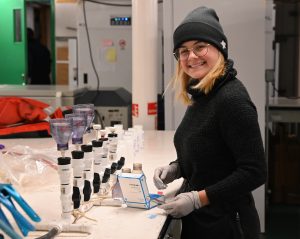 the area. So, this will be Station PS1. The usual samples: a bacterivory experiment, primary production (photosynthesis), bacterial production, filtering for bacterial and protistan DNA/RNA, chlorophyll, dissolved nutrients. That’s Liz Everett on the left, filtering water to determine chlorophyll and dissolved nutrients. Chris Carnivale is across the table filtering for microplastics. We learned that two ships apparently were fishing at Kim’s sampling station in Wilhelmina Bay. We’ll see what’s what tomorrow night. There was a check in for Covid tests for those overwintering – the station’s doctor came on board to give them. Then we were supposed to leave for Wilhelmina Bay, but there is some sort of hold up and we are sitting off of Palmer Station waiting to hear. While we were waiting, we did some back deck training in our float coats and boots – climbing the Jacob’s ladder (basically a rope ladder with wooden rungs). I’ve tossed in a couple of photos.
the area. So, this will be Station PS1. The usual samples: a bacterivory experiment, primary production (photosynthesis), bacterial production, filtering for bacterial and protistan DNA/RNA, chlorophyll, dissolved nutrients. That’s Liz Everett on the left, filtering water to determine chlorophyll and dissolved nutrients. Chris Carnivale is across the table filtering for microplastics. We learned that two ships apparently were fishing at Kim’s sampling station in Wilhelmina Bay. We’ll see what’s what tomorrow night. There was a check in for Covid tests for those overwintering – the station’s doctor came on board to give them. Then we were supposed to leave for Wilhelmina Bay, but there is some sort of hold up and we are sitting off of Palmer Station waiting to hear. While we were waiting, we did some back deck training in our float coats and boots – climbing the Jacob’s ladder (basically a rope ladder with wooden rungs). I’ve tossed in a couple of photos.
(below) The other U.S. icebreaker, L.M. Gould, at the Palmer Station dock viewed from our ship. They will be leaving for Chile soon.
This is what we refer to as the CTD that we use to examine the water column and take samples. In reality, what you are looking at is the rosette of Niskin bottles. The CTD (Conductance, 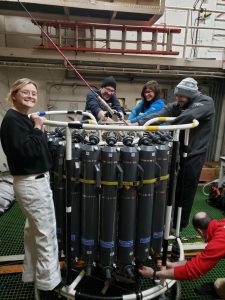 Temperature,
Temperature,
Depth) instrument is underneath the rosette. Other instruments are also often placed under the rosette to measure things like fluorescence, light transmission, etc. The rosette of bottles is what we use to collect water. We are reaching into the middle to cock the bottles. A spring or rubber tubing is attached to the top and bottom and when released it pulls them together and closes the bottle. The steel cable attached to the frame also carries signals that close the bottles via computer at the depths we choose after we seen continuous traces of data as it drops. Once it is back on deck, the little white spouts on the bottom have tubing slipped on and the bottles are drained into containers for experiments or measurements of environmental components.
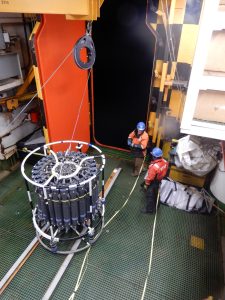 The photo of the CTD exiting to the left was taken by Karl Newyear. He’s the MPC (Marine Program Coordinator) for this expedition. That means he is the official coordinator between the “visiting” scientists and the team of marine technicians and electronic technicians that keep things running for the scientists.
The photo of the CTD exiting to the left was taken by Karl Newyear. He’s the MPC (Marine Program Coordinator) for this expedition. That means he is the official coordinator between the “visiting” scientists and the team of marine technicians and electronic technicians that keep things running for the scientists.
The photo to the right is most of the mixo team reviewing the data on depth, salinity, temperature & fluorescence on a computer in the dry lab in real time. This is how we choose depths to samples. Usually looking for a distinct change in one or more of these properties where we expect from our experience that there may be concentrations of microorganisms.
May 26 – Thursday – Today our team did another cast in the Palmer Deep near Palmer Station (PS2; (64 57.251 S, 64 18.88 W), no ice) – this one was actually pretty deep – to 1385 meters. We sampled from 8 depths between 08:52 and 09:15. We ran experiments from a couple of depths, but the rest was just filtered for species diversity (DNA). Still, our experiments and data gathering lasted much of the day. After dark, the Bernard team (krill) spent all night with a sonar looking for aggregations of krill without success. They didn’t even put the net in the water.
May 27 – Friday – Today our team did another cast in the Palmer Deep near Palmer Station – but not so deep – to 730 meters. We sampled from 4 depths and ran experiments at three depths (deepest was for DNA diversity only). This did take us until dinner time to finish. I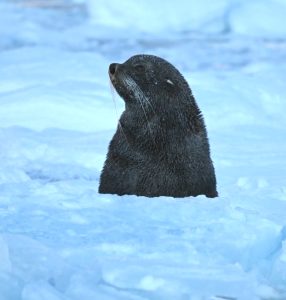
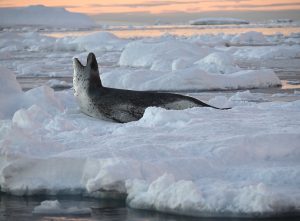 n the meantime, the seal team (Luis Huckstadt group) had some training on the zodiacs (rubber boats with outboard motors). There are some graduate students that are inexperienced, and they wanted to have some practice in relatively calm waters. They were able to get on some ice foes and took lots of seal pictures. The photos of seals here were taken by Dan Costa. A fur seal and a leopard seal. Guess which is which!
n the meantime, the seal team (Luis Huckstadt group) had some training on the zodiacs (rubber boats with outboard motors). There are some graduate students that are inexperienced, and they wanted to have some practice in relatively calm waters. They were able to get on some ice foes and took lots of seal pictures. The photos of seals here were taken by Dan Costa. A fur seal and a leopard seal. Guess which is which!
After that, we had dinner and then the krill team (Bernard group) began using sonar to look for krill. The krill migrate toward the bottom in the day and come back up at night, so that’s why they only try to catch them after dark. They saw signals indicating krill on the sonar, put the net out and had a successful haul. I wandered up to my cabin thinking how great it was to have a successful day.
The photos below were taken by Mike Tift, a member of the seal team. The net coming on board, a cooler of krill, the Bernard team estimating number of krill captured, Kim Bernard counting krill.
About 10:30 pm I got a call to come down because they had a second successful tow and had captured all the krill they need for their experiments this winter at Palmer Station! As Chief Scientist, I had to decide what the ship should do. After consultations, I decided we would head directly to Palmer Station, offload the krill, two members of their team and some supplies for the people overwintering at the station. This will put us back on schedule after we lost time over the past couple of days.
May 28 – Saturday – We arrived before dawn at Palmer Station and began to tie up to the pier starting about 10:30. We aren’t allowed to go ashore, so I sat at my computer for much of the day. I did watch them working for a few minutes, but since I have little investment in the cargo, I went back to work. We will remain tied to the dock overnight and tomorrow they will transfer fuel to the station for heating, vehicles, etc.
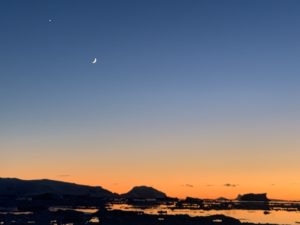 May 29 – Sunday – Spent the morning docked at Palmer Station transferring fuel to the station. The seal team also had some syringes pre-weighed, which took some time, but we were finally off around 2:30 pm. I took some pictures of sunset about 4:30 and met with the captain to plan the next day. Our team will sample at a station that we had visited before near the mouth of the Grandidier Channel (65.4925 S 64.547W) at 5 am tomorrow.
May 29 – Sunday – Spent the morning docked at Palmer Station transferring fuel to the station. The seal team also had some syringes pre-weighed, which took some time, but we were finally off around 2:30 pm. I took some pictures of sunset about 4:30 and met with the captain to plan the next day. Our team will sample at a station that we had visited before near the mouth of the Grandidier Channel (65.4925 S 64.547W) at 5 am tomorrow.
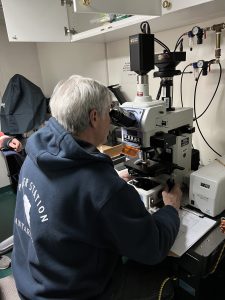 We made some slides and checked them under the fluorescence microscope and will increase our sample size in the future because the algal abundance is very low for counting. It’s what we expected, but there’s little documentation from this time of year. Went to 03 deck and played Scategories for an hour after dinner.
We made some slides and checked them under the fluorescence microscope and will increase our sample size in the future because the algal abundance is very low for counting. It’s what we expected, but there’s little documentation from this time of year. Went to 03 deck and played Scategories for an hour after dinner.
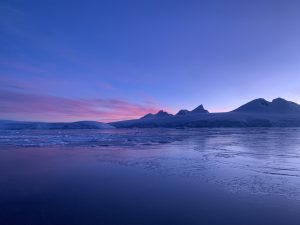
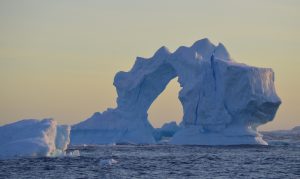 May 30 – Monday – Sampled at 5:10 am this morning (Station PS 4, 65° 29.5 S, 65° 29.54 W; pancake ice). We did a plankton tow and a CTD cast – four depths. Kept us busy all day until dinner. It was dark when we sampled and I did get a chance to get the picture of sunrise on the left. Also to the left is an interesting ice berg we passed today. I think it will collapse upon itself soon.
May 30 – Monday – Sampled at 5:10 am this morning (Station PS 4, 65° 29.5 S, 65° 29.54 W; pancake ice). We did a plankton tow and a CTD cast – four depths. Kept us busy all day until dinner. It was dark when we sampled and I did get a chance to get the picture of sunrise on the left. Also to the left is an interesting ice berg we passed today. I think it will collapse upon itself soon.
At 5:37 pm we crossed the Arctic Circle (66° 33’ S latitude). We are moving west right at the Circle right now, so we’ve crossed it a couple of times since. We’ll head further south once we get around Adelaide Island. The photo is one of the data displays in the “dry lab” where several of us work on computers and look at charts (paper ones). The latitude and longitude are at the top showing that we just passed the Antarctic Circle. Other data includes seawater temperature (the ship has flow-through seawater and you can see that the water enters and leaves below freezing [for fresh water]); seawater doesn’t freeze until it is -2°C (about 28.5°F). The water depth is 406 meters.
May 31 – Tuesday – No new samples taken today. We are finishing up some shipboard experiments and the Huckstadt team needed time to search for seals. So that’s what we did. Sunlight isn’t obvious until after 10 am and it is getting dark before 3 pm. The Huckstadt team can work on floes in the dusk and tag seals but the window of time for spotting them with binoculars, getting dressed, putting the Zodiacs in the water and reaching the floe is tight. Today they approached three different seals in the Zodiacs, but the seals slipped into the ocean. Then it was dark. The Bernard team searched for schools of krill with sonar and were able to net some after I went to bed – but not enough to start their big 5-day growth experiment.
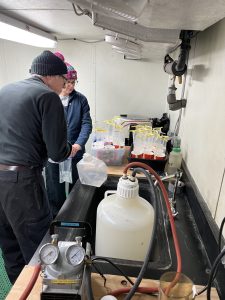 June 1 – Wednesday – Another CTD at 06:00 this morning of the east side of Alexander Island (68° 49.86’S 69° 50.6’ W). Sampled from five depths, usual data collections, but chlorophyll fluorescence (a phytoplankton proxy) was very low, so we did the bacterivory experiments only at the depth closest to the surface (bacterivory experiments measure feeding on bacteria by protozoa and mixotrophic algae). That’s Becky Gast and me setting up a bacterivory experiment in one of the walk-in freezers where we work so the organisms don’t warm up and die. There are two of the freezers on the ship. Ours is the smaller one and is called “Little Antarctica.” We also did an additional light reading (called Profiling Reflectance Radiometer or PRR for short) to 50 m and a plankton tow. At about 1:30 this afternoon the seal team gave up searching because of increasingly high winds would prevent them from deploying the Zodiac. The photos are of Liz Everett and Leila Harris (and Jay Diii Grattepanche) deploying the PRR off the aft of the ship. The instrument is in Liz’s hand, ready to go over, and Jay Diii and Leila are rolling out the cable that is connected to a recording instrument and computer protected inside the ship.
June 1 – Wednesday – Another CTD at 06:00 this morning of the east side of Alexander Island (68° 49.86’S 69° 50.6’ W). Sampled from five depths, usual data collections, but chlorophyll fluorescence (a phytoplankton proxy) was very low, so we did the bacterivory experiments only at the depth closest to the surface (bacterivory experiments measure feeding on bacteria by protozoa and mixotrophic algae). That’s Becky Gast and me setting up a bacterivory experiment in one of the walk-in freezers where we work so the organisms don’t warm up and die. There are two of the freezers on the ship. Ours is the smaller one and is called “Little Antarctica.” We also did an additional light reading (called Profiling Reflectance Radiometer or PRR for short) to 50 m and a plankton tow. At about 1:30 this afternoon the seal team gave up searching because of increasingly high winds would prevent them from deploying the Zodiac. The photos are of Liz Everett and Leila Harris (and Jay Diii Grattepanche) deploying the PRR off the aft of the ship. The instrument is in Liz’s hand, ready to go over, and Jay Diii and Leila are rolling out the cable that is connected to a recording instrument and computer protected inside the ship.
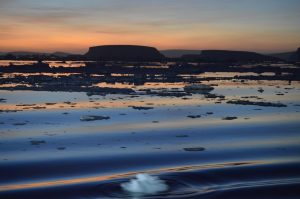 It is also overcast and snowing and beginning to get dark. We are heading north along the coast of Alexander Island to the spot where we did a CTD cast because the sonar was running this morning and looking back, the Bernard team thought it indicated there might be krill there. The photo on the right is from last Sunday, but the blog needed a little color here.
It is also overcast and snowing and beginning to get dark. We are heading north along the coast of Alexander Island to the spot where we did a CTD cast because the sonar was running this morning and looking back, the Bernard team thought it indicated there might be krill there. The photo on the right is from last Sunday, but the blog needed a little color here.
The sonar suggested krill just before sundown (about 3:30 pm) and the IKMT plankton net (Isaacs-Kidd midwater trawl) was deployed off the stern A-frame. They caught enough krill for their 5-day growth experiment, which is good because we will have to head back north within the week. They want to stay in the same general area since the water pumped through their tank will contain the same food concentration that is in the local environment. The fluorescence in the area was quite low, so not a lot of phytoplankton, but we saw ciliates in our plankton net tow, which has a much smaller mesh size (and mouth diameter) than the LKMT used to catch the krill.
I realized that I never indicated that the major part of our project in Antarctica is to study the feeding activity and diversity of mixotrophic algae! Here’s a link on my website that explains a little bit about mixotrophic phytoplankton and what they do in the environment.
Finally, a shout out to Dr. Sarah Princiotta. Happy Birthday Sarah! ????????!
June 2 – Thursday – My group did not sample today. We worked on the data we’ve collected and made microscope slides to determine the abundance of phototrophic, mixotrophic and heterotrophic flagellates. Those are flagellated protists that rely entirely on the sun for photosynthesis, can photosynthesize and also ingest particulate food, and have zero photosynthetic abilities, respectively. It was windy, which made it was hard to use the microscope, so a lot of today was paperwork. I wrote up a weekly report for the National Science Foundation – I’m required to do that as chief scientist. It’s like this blog, but a little less chatty and with some different details. The seal team spotted seals, got into Zodiacs and again were able to get close to a crabeater seal, but the wind was too strong for them to get onto the floe and it was getting dark – so another disappointing day for them. 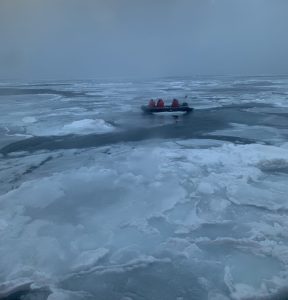 That’s them returning on one of the zodiacs. The krill team used nets to catch krill at several depths. This time they didn’t target them with the sonar, but instead put over a MOCNESS (Multiple Opening/Closing Net and Environmental Sensing System) that can close different nets at several depths. That allows them to determine the abundance of the krill at the different depths in the area. They were successful and their data will contribute to an understanding of krill distribution and what their food is during a time of the year when there isn’t high algae growth. During the evening, we used markers to draw on Styrofoam cups because we have a deep CTD cast tomorrow – read more below.
That’s them returning on one of the zodiacs. The krill team used nets to catch krill at several depths. This time they didn’t target them with the sonar, but instead put over a MOCNESS (Multiple Opening/Closing Net and Environmental Sensing System) that can close different nets at several depths. That allows them to determine the abundance of the krill at the different depths in the area. They were successful and their data will contribute to an understanding of krill distribution and what their food is during a time of the year when there isn’t high algae growth. During the evening, we used markers to draw on Styrofoam cups because we have a deep CTD cast tomorrow – read more below.
June 3 – Friday – Another CTD at 06:00 this morning by my team on the northwest side of Alexander Island (68° 59.874’S 72° 43.37’ W) in a deeper area (1,720 meters). Sampled from eight depths, with the usual data collections nearest surface (20 meters deep), but mostly just DNA to identify protists and bacteria at the other depths. Because we knew we would do some deep casts like this we planned ahead for a little entertainment and brought some Styrofoam cups and Sharpie markers. Atmospheric pressure increases the deeper one goes and because Styrofoam has lots of tiny air pockets the pressure crushes them and makes them smaller. The cups are put in a mesh bag and tied to the CTD. Thus, you can draw pictures and write on a cup and when it comes back up, it (usually) has been compressed into a tinier version of whatever you drew. Last night we set out the markers and cups and let everyone that wanted create cup art have one or two to send down. Some people showed a lot of artistic talent.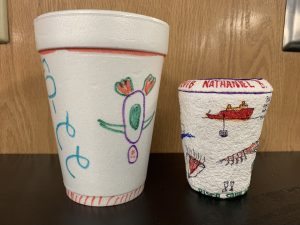
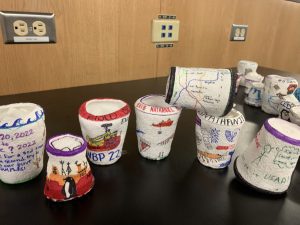
The picture on the left or scale – a normal cup and a cup from the mixo team that was compressed by going 1700 meters deep. Just below are the compressed cups from our team.
After that excitement we had a lot of work that kept us busy until dinner. The seal team went out again in two Zodiacs after siting two crabeater seals, but when the team went around an iceberg to tag them, one had serious injuries from a leopard seal attack and the other was on a rather thin ice floe. And then a large leopard seal began to chase one of the zodiacs. So there was some excitement, but no tagging. It has been a tough expedition for the seal team. As I write this, we have a large net out capturing krill and fish if they are there for abundance estimates. It’s 9:30 pm and I’ve been up since 4:30 am, so I’m headed to my bunk as soon as I post this. Our internet was unexplainably better today, but we were generally too busy to use our allotments.
June 4 – Saturday – Before anything else today . . .
HAPPY BIRTHDAY NICK !
The mixotrophy team will be taking a break from sampling today and probably tomorrow in order to stay in this area and search for crabeater seals. They spotted one this afternoon and were almost close enough to tag, but it slipped into the water . . . again. Up in the bridge, we saw three more seals, but they appeared to be on ice floes that were too small. Tonight we did a CTD to 1200 meters – just for DNA and the krillers sampled again with the MOCNESS. After that we are headed east across Marguerite Bay where we will hopefully encounter thicker ice floes and lots of seals.
June 5 – Sunday – Once again, the day started with the seal team on the bridge looking for crabeater seals on appropriately thick ice floes – thick enough so that the team members could get on the floe to tag them. They spotted lots of crabeaters but they were all on floes that were too small or too thin to allow tagging. 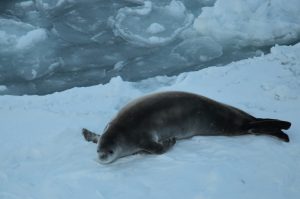 The seal team called off their search before it was truly dark. Crabeater seals (the photo to the right was taken by Jay Diii Grattepanche) are harder to tag than some other species because they are not colonial. So, researchers must approach single seals or seal pairs on ice floes as I’ve described here. Why are they were called crabeater seals? It isn’t clear, at least to me, since their diet is probably 98% krill with some fish thrown in.
The seal team called off their search before it was truly dark. Crabeater seals (the photo to the right was taken by Jay Diii Grattepanche) are harder to tag than some other species because they are not colonial. So, researchers must approach single seals or seal pairs on ice floes as I’ve described here. Why are they were called crabeater seals? It isn’t clear, at least to me, since their diet is probably 98% krill with some fish thrown in.
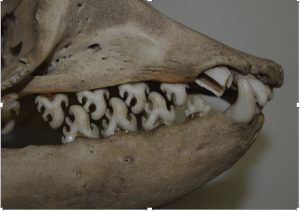 To the left is a picture of a crabeater skull that I took at the Antarctic museum in Christ Church, New Zealand on a previous trip to the Ross Sea. See how the cusps on the teeth are modified to act like a sieve – water can be forced out, but krill are trapped. Shortly before the crabeater team stopped their daily search, the captain approached me and said the weather report predicted high winds tomorrow – up to 50 knots (nautical miles per hour), so we are doing a CTD cast for our work tonight rather than tomorrow morning. In addition to our usual experiments and collections we will be setting up a larger 5-day incubation in the deck incubators that have flowthrough seawater to keep the experiment at the correct temperature and allow what little light there is to reach the samples. As we approached our station – one we sampled in our November/December 2019 trip – the sonar indicated large aggregations of krill and the krillers will be sampling with three types of nets again tonight beginning right after we bring the CTD onboard. All three nets were deployed and some krill were caught, but the aggregations that we saw on the instruments earlier were not in this area.
To the left is a picture of a crabeater skull that I took at the Antarctic museum in Christ Church, New Zealand on a previous trip to the Ross Sea. See how the cusps on the teeth are modified to act like a sieve – water can be forced out, but krill are trapped. Shortly before the crabeater team stopped their daily search, the captain approached me and said the weather report predicted high winds tomorrow – up to 50 knots (nautical miles per hour), so we are doing a CTD cast for our work tonight rather than tomorrow morning. In addition to our usual experiments and collections we will be setting up a larger 5-day incubation in the deck incubators that have flowthrough seawater to keep the experiment at the correct temperature and allow what little light there is to reach the samples. As we approached our station – one we sampled in our November/December 2019 trip – the sonar indicated large aggregations of krill and the krillers will be sampling with three types of nets again tonight beginning right after we bring the CTD onboard. All three nets were deployed and some krill were caught, but the aggregations that we saw on the instruments earlier were not in this area.
June 6 – Monday – 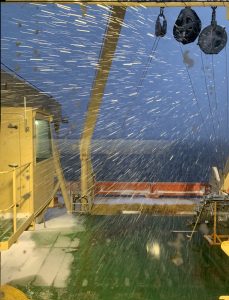 The predicted high winds arrived this morning. We moved in closer to the shore near Pourquoi Pas Island (why not?) so that the coastal mountains would block the winds somewhat – they did drop from 50 knot gusts offshore to 15-20 knots in our current position. But the fog and snow (right) have made searching for seals unrealistic. We are still planning to do a CTD cast tonight or possibly tomorrow depending on the wind speed and direction, and are heading back out in that general direction. In the meantime, here are a few photos taken over the past few days of some of the mixotrophy team.
The predicted high winds arrived this morning. We moved in closer to the shore near Pourquoi Pas Island (why not?) so that the coastal mountains would block the winds somewhat – they did drop from 50 knot gusts offshore to 15-20 knots in our current position. But the fog and snow (right) have made searching for seals unrealistic. We are still planning to do a CTD cast tonight or possibly tomorrow depending on the wind speed and direction, and are heading back out in that general direction. In the meantime, here are a few photos taken over the past few days of some of the mixotrophy team.
Bob & Becky in front of our outdoor incubators;
Jay Diii and Becky;
Chris;
Jay Diii.
June 7 – Tuesday – Today we are the most southerly ship in the world. The next furthest south is in a fishing fleet off the Western Antarctic Peninsula – basically where we are headed in the next day or so. We caught up with making slides for epifluorescence microscopy today. We had hoped to enumerate the phytoplankton and mixotrophs on board the ship, but the filter sets for the excitation and fluorescence light in the microscope here was just slightly off and made them hard to count. So instead, we will freeze them at -80°C and transport them on dry ice back to our labs in the U.S. But . . . today was finally a day for the seal team. They were able to tag a crabeater seal. They could have tagged two, but the wind began to pick up and it became too dangerous to work on a floe. Today was supposed to be our last day in the south, but given their success, we will extend their opportunities here for another day. We debated whether or not we should sample another station in the south since we were near one that we sampled in December 2019. We decided to go for it. In the meantime, we received a request for a medical evacuation from the Rothera Station (British). Nothing serious, but one of their team has some sort of issue that the British decided that she should not overwinter. We are the last ship to be in the area until austral spring, so they asked for her to accompany us to Punta Arenas for a flight back to Great Britain.
June 8 – Wednesday – We are still the most southerly ship in the world. We had a CTD cast at 06:00 this morning. It was tough since, for some unexplained reason, most of the mixo team slept poorly. In addition to our usual collections, we set up another 4-day experiment with bacteria labeled with a nucleotide substitute that gets incorporated into the DNA of the protists that ingest the labeled bacteria. Then we can sequence the protist DNA and know the species that are eating bacteria.
It was too rough for the seal team to even get into the zodiacs, so I made the call to start heading north. The captain suggested we try to go north through several channels including “Tickle Passage” . . . hard to believe that’s really a place. But as we moved up the channel it got windy, narrow and visibility dropped with heavy snowfall. So we turned around and are going around the southern end of Adelaide Island into more open ocean where there are fewer small floating icebergs (called growlers if I didn’t write that already). After dinner, the marine techs set up the ping pong table in the helicopter hanger and people played for about an hour until it got a little too rough and rolling – calling it off about 7:30. I visited the bridge and spoke to the captain to confirm that we would do a CTD cast tomorrow morning at a site at the northwest end of Adelaide depending on weather and wave height. We are turning the southern end of the island now and have about 60 nautical miles to go to our site. If we go 10 knots per hour which is our top normal running speed, that’s about 6 hours. But we may well slow down and the captain may decide to go past our station and seek calmer waters to wait out the rough weather. It’s about 9 pm and almost everyone has disappeared to their cabins, probably due to the weather and rolling ship. I’ll probably go up to my cabin, too, and read after I post this.
June 9 – Thursday INTERNET IS BACK BRIEFLY; POSTING ON JUNE 12 for June 9-12 – Today I planned to arise early and consult with the captain about the feasibility of a CTD cast, but I overslept and had to rush to prepare my part of the experimental setup. We sampled about 08:00 in ~700 meters of water. This was an offshore station (PS 11) that we sampled also in December 2019 (Sta. O). We then moved immediately to inside the northeast end of Adelaide Island for some better protection from the wind. The weather was overcast with heavy snow, so visibility was low, and the winds were still substantial, so the seal team was shut down. We decided to stay in the general area and give the seal team another chance the next morning. We worked in the dry lab on various projects, played a few rounds of cribbage and prepared the lab for rough weather – the forecast does not look better. I tried to log on and post to the blog, but the internet would not cooperate.
June 10 – Friday – Today I did get up early hoping for better internet, but alas, we had been cut to using 80 MB per day and that wasn’t cooperative either. So I printed out the NYT crossword puzzle (we get a 10+ page synopsis of the news plus the crossword puzzle). Met with Luis Huckstadt and the captain on the bridge and agreed that there was no chance for the seal team to have success in this area – it was snowing hard still, and the wind was picking up. I went back to the main deck and found Jay Diii and Becky getting ready to break down an experiment in the outdoor incubators on the helo deck, so I went out to help them. Then Leila came down for help ending an experiment in the rad van. It was getting windier, and the ship was rolling. I didn’t want anyone outside alone, so I went up and helped her with the radioisotope experiment in the rad van. We were approaching open ocean again and the wind was strong – 50 knot gusts – and most people disappeared to their rooms or to the lounge to watch movies. There’s not much one can do in the labs with the seas this rough. 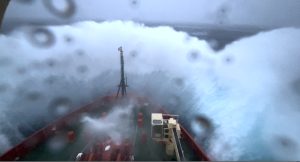 I spent as couple of hours on the bridge watching waves break over the bow. That’s the wave crashing over the bow of the ship in the photo. Then met with others to discuss plans for the crossing ceremony (See end of blog).
I spent as couple of hours on the bridge watching waves break over the bow. That’s the wave crashing over the bow of the ship in the photo. Then met with others to discuss plans for the crossing ceremony (See end of blog).
June 11 – Saturday – By 08:00 this morning, we had reached 64 55 South and were to the west of Palmer Station. Swells were conspicuously larger overnight and this morning; morning being relative – it’s almost 09:00 and still no sign of light. We have noticeable and constant side-to-side rolls rather than the up/down of the bow to stern movement of yesterday. For the first time, the grips on my bedside table didn’t keep my book from sliding off onto the floor and the duct tape holding the drawer closed gave way. The ship’s roll is such that you run toward the side of the ship or struggle up hill, and then switch, nearly every time you stand to go somewhere. Relatively few people at breakfast today.
Once we start to proceed east past Palmer Station toward the Gerlache Strait we had much less movement. And yes, we are back in the area of our northern science stations. We hope to sample a bit farther north in the Gerlache than we did on our way from Chile to Palmer Station. The seal team expects more crabeater seals (and hopefully better ice floes and weather) in this area.
After I started today’s post (still waiting internet connection to upload), we realized that visibility was 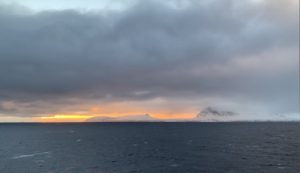 poor and the ice floes weren’t much better, so we decided to proceed to a new station further north than any we have taken. The sunset to the left is in the Gerlache on the way north. By doing this we will expand our geographic area of study both south and north of our stations from previous expeditions. We arrived just at dinner and decided to sample tonight rather than tomorrow. We (meaning mostly Jay Diii) have two larger experiments to finish tomorrow, so sampling and starting a new 4-day experiment tonight makes more sense than tying things up tomorrow morning. Sampling went fine, the krill team saw krill on the sonar as we approached our station and were able to catch enough to start their multi-day experiment. We will head back south tonight and sit outside Wilhelmina Bay. The krill team searched for animals in Wilhelmina all night earlier in the expedition, but the seal team didn’t have a chance to look for seals, which is what will happen all day tomorrow. Hopefully I‘ll be able to post this.
poor and the ice floes weren’t much better, so we decided to proceed to a new station further north than any we have taken. The sunset to the left is in the Gerlache on the way north. By doing this we will expand our geographic area of study both south and north of our stations from previous expeditions. We arrived just at dinner and decided to sample tonight rather than tomorrow. We (meaning mostly Jay Diii) have two larger experiments to finish tomorrow, so sampling and starting a new 4-day experiment tonight makes more sense than tying things up tomorrow morning. Sampling went fine, the krill team saw krill on the sonar as we approached our station and were able to catch enough to start their multi-day experiment. We will head back south tonight and sit outside Wilhelmina Bay. The krill team searched for animals in Wilhelmina all night earlier in the expedition, but the seal team didn’t have a chance to look for seals, which is what will happen all day tomorrow. Hopefully I‘ll be able to post this.
June 12 – Sunday – I slept late this morning and we were moving into Wilhelmina Bay when I came down to the lab. It wasn’t until after lunch that the sealers spotted a crabeater on an appropriate floe. We were just about to put out the plankton net, but got out of the way so they could get the zodiacs over and head toward the seal. Success! They were able to tag a seal! I suspect we will stay here for another day. Depends a bit on whether the krill teams wants to do surveys to estimate populations – they caught enough for their experiments last night. We will take the ship outside of the bay into the Gerlache for another CTD cast tomorrow morning. It will still be dark when the CTD is back on board, so the sealers can begin looking for another tagging opportunity after sunrise.
June 13 – Monday – A six am CTD cast in the Gerlache Strait for us this morning. If you’re tired of reading about them, think how tired we are of doing them! Kidding. It keeps us busy, and we will have a lot of data to analyze when we get home. That’s Bob, Chris and Becky getting water samples out of the Niskin bottles
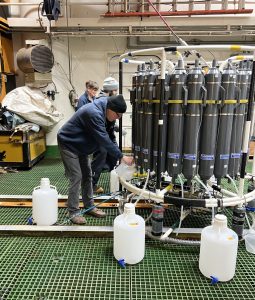 Jay Diii has been accumulating and graphing the environmental data for each station, which is helpful in deciding where to sample next now that we are back in an area where we have been before. After we finished the cast and were working in the lab, the ship began to move deeper into Wilhelmina Bay. But it was windy (30 knot gusts) and snowing hard, so visibility was poor and the captain decided to keep the ship in the deeper water of the Gerlache. So no luck for the sealers once again. It remains to be seen whether there will be any net tows for krill tonight. Wind may preclude them.
Jay Diii has been accumulating and graphing the environmental data for each station, which is helpful in deciding where to sample next now that we are back in an area where we have been before. After we finished the cast and were working in the lab, the ship began to move deeper into Wilhelmina Bay. But it was windy (30 knot gusts) and snowing hard, so visibility was poor and the captain decided to keep the ship in the deeper water of the Gerlache. So no luck for the sealers once again. It remains to be seen whether there will be any net tows for krill tonight. Wind may preclude them.
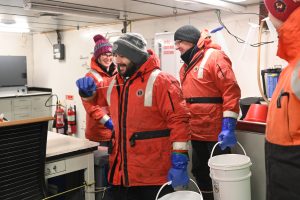 We also started another 4-day experiment in the deck incubators this afternoon. I inserted some pictures of us walking through snow to start it.
We also started another 4-day experiment in the deck incubators this afternoon. I inserted some pictures of us walking through snow to start it.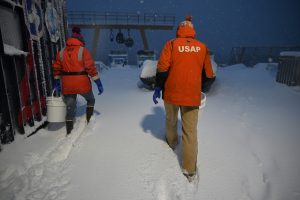
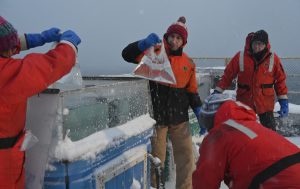
But we are finally approaching the end of the quarantine and expedition. We will sample every other day for the next week and then we go to Palmer Station to drop off some cargo and pick up the scientists that are not overwintering to take them back to Punta Arenas. Probably 4 days to cross the Drake Passage and a day+ in Punta Arenas before flying to Santiago.
June 14 – Tuesday – The Mixo team did not sample with a CTD cast today and the wind picked up to 40-50 knot gusts, so we cancelled the light profile (PRR) and plankton tow as well. During the daylight we cruised through Wilhelmina Bay looking for seals – only saw a few fur seals – not the target animals. The photo is of the moonrise. After dark, the krill team had a shallow CTD and did their series of three types of plankton nets finishing late. Our plan is for a CTD tomorrow morning.
June 15 – Wednesday – Pisco Sour 14– The Mixo team was up for a 6 am CTD, but by the time I was in the lab at 05: 30, Jay Diii had already called the bridge and postponed the cast. Winds were sustained between 25-30 knots with gusts to 50 knots (nautical miles per hour, a little greater than MPH). We discussed among ourselves what we should do and decided to move north toward Wilhelmina Bay for the CTD or to go into the channel between Anvers Island and Brabant Island. I had heard three versions of where the seal team wanted to be during daylight and north is appropriate for two of them.
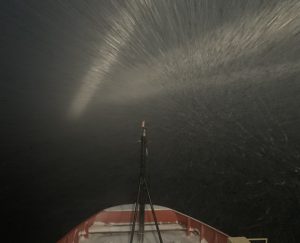 By 08:00 am, we had decided to go into the channel between Anvers and Brabant Islands. When I went to the bridge, I realized it was snowing very hard, the winds were not subsiding and agreed with the Captain to play it by ear until there was some visibility. The photo is from the bridge – snow blowing through the spotlights at 10:00 am. Yes it is still dark and will be for another hour at least. By 09:00, we had decided within our group to cancel today’s CTD. Then, after lunch we passed our proposed station between Anvers and Brabant Islands and when a bit further into some small bays. It was foggy, so the sealers gave up. But the winds had dropped substantially so we went back to our station and had a CTD cast at 1430 (230 pm) and set up a nutrient amendment experiment. We went back to the Gerlache Strait and the krill team is currently doing a net tow.
By 08:00 am, we had decided to go into the channel between Anvers and Brabant Islands. When I went to the bridge, I realized it was snowing very hard, the winds were not subsiding and agreed with the Captain to play it by ear until there was some visibility. The photo is from the bridge – snow blowing through the spotlights at 10:00 am. Yes it is still dark and will be for another hour at least. By 09:00, we had decided within our group to cancel today’s CTD. Then, after lunch we passed our proposed station between Anvers and Brabant Islands and when a bit further into some small bays. It was foggy, so the sealers gave up. But the winds had dropped substantially so we went back to our station and had a CTD cast at 1430 (230 pm) and set up a nutrient amendment experiment. We went back to the Gerlache Strait and the krill team is currently doing a net tow.
June 16 – Thursday – Today was not a sampling day for the mixo team. We caught up with some filtering, watched for seals from the bridge (Becky & Bob on Bridge), crunched data, discussed who would write various manuscripts and thought of Leila as she had to finish up experiments in the rad van since we had a late start yesterday. 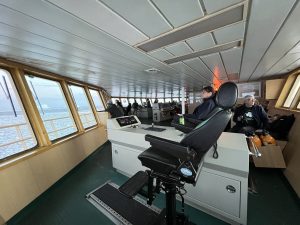 The ship moved back to Wilhelmina Bay and the seal team searched from the bridge and then went out in the zodiacs to get closer to shore than we could go in the ship to search for seals. They had given up and were returning to the ship when they spotted a crabeater seal on a workable ice floe. They were able to tag it and weigh it and got back to the ship well after dark. The krill team was delayed in starting their net tows, but proceeded to the Gerlache and got the nets in (all three types) and finished before midnight. They also finished their ‘northern’ krill growth experiment. Then we began moving toward Paradise Harbor for tomorrow’s CTDs.
The ship moved back to Wilhelmina Bay and the seal team searched from the bridge and then went out in the zodiacs to get closer to shore than we could go in the ship to search for seals. They had given up and were returning to the ship when they spotted a crabeater seal on a workable ice floe. They were able to tag it and weigh it and got back to the ship well after dark. The krill team was delayed in starting their net tows, but proceeded to the Gerlache and got the nets in (all three types) and finished before midnight. They also finished their ‘northern’ krill growth experiment. Then we began moving toward Paradise Harbor for tomorrow’s CTDs.
June 17 – Friday – PiscoSour 15 – The Mixo team was at 6 am for our first CTD in Paradise Harbor. We sampled here previously in 2019, and again sampled more depths than usual today to match sample depths from those visits. The second cast at 8 am was to get multiple depths for DNA and plastics to complete comparative data sets from early austral summer. All went well. The sealers spotted a crabbie on a decent floe and set out on a tagging mission. The engine on one of the zodiacs pooped out and they had to pull it out of the water and put another in. The seal team needs two in order to hold people and supplies. This killed the chance for some late afternoon “recreational” boating to allow all the scientists an opportunity to cruise around among the ice flows. Sealers out until dusk but unable to tag. Maybe tomorrow . . . but that has almost become their credo. How frustrating. Krillers are planning another net tow for after dinner. It was called off for high winds.
June 18 – Saturday – The Mixo team has completed all major sampling – with one more CTD just before we dock at Palmer Station to pick up 16 people who are returning to the U.S. Our measurements that require radioisotopes have to be shut down, so running additional CTDs makes little sense. Especially since we have samples this area in both seasons, including the current voyage. Jay Diii will take the one last CTD cast for DNA samples on the day we head into Palmer Station, but that only involves filtering the water and freezing the samples at -80° until we return and process them in Philadelphia (they are sent back separately on dry ice). We have one experiment still running in the deck incubators – it will be finished tomorrow. The weather today is relatively calm, and the seal team expects to go out, perhaps putting boats in the water and following the Palmer as a new strategy. After lunch, 2 zodiacs deployed. Chris is “part of the seal team” and Liz, Leila and JayDiii went along as tourists (recreational). They put out a 3rd boat, and Becky and two others got geared up in warm, waterproof clothing to go out as observers, but the zodiac’s outboard motor would not start after it got into the water. The zodiacs were out for about 4-5 hours, so everyone returned cold, but the observers were happy to have had the opportunity. They got close to some colonies of Gentoo penguins and JayDiii got some great pictures.
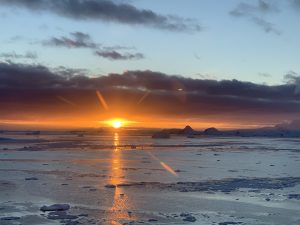 June 19 – Sunday – Today I was up early and much later took the photo of sunrise . . . it was almost 11 am for this picture. We worked in the lab, trying to finish up making microscope slides that we will send back to Temple and Woods Hole frozen for epifluorescence microscopy there. We must keep them frozen because otherwise, the chlorophyll in the phytoplankton cells begins to deteriorate and they lose the red fluorescence that we need to identify them as being photosynthetic. Also spent some time on the bridge, looking for seals, but generally just sightseeing and taking some pictures. We also thought twice that we would be going out in the Zodiac and got all geared up. First time was cancelled, but they decided to take us out after sundown when the sealers returned from tagging a seal.
June 19 – Sunday – Today I was up early and much later took the photo of sunrise . . . it was almost 11 am for this picture. We worked in the lab, trying to finish up making microscope slides that we will send back to Temple and Woods Hole frozen for epifluorescence microscopy there. We must keep them frozen because otherwise, the chlorophyll in the phytoplankton cells begins to deteriorate and they lose the red fluorescence that we need to identify them as being photosynthetic. Also spent some time on the bridge, looking for seals, but generally just sightseeing and taking some pictures. We also thought twice that we would be going out in the Zodiac and got all geared up. First time was cancelled, but they decided to take us out after sundown when the sealers returned from tagging a seal.
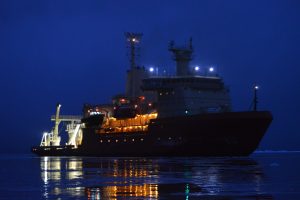 It was refreshing to get off the ship – first time in over a month. I’ve been in zodiacs in Antarctica before, but never in the dark. It was quite beautiful. That’s the ship from the zodiac. From our group it was Becky, Leila and me; Guilia from the krill team and Trevor the third mate. This will probably be his only time in Antarctica – he usually works the Gulf of Mexico (the company that supplies the ship’s crew runs out of Louisiana). The third mate is one of four people that split driving the ship – Captain, 1st-, 2nd-, and 3rd-mates. Each mate has two 4-hour watches split by 16 hours so they have a routine for getting rest. The Captain is on the bridge much of the day and night – especially in the ice or bad weather. Once we returned from our zodiac trip we snacked, warmed up and watched a movie.
It was refreshing to get off the ship – first time in over a month. I’ve been in zodiacs in Antarctica before, but never in the dark. It was quite beautiful. That’s the ship from the zodiac. From our group it was Becky, Leila and me; Guilia from the krill team and Trevor the third mate. This will probably be his only time in Antarctica – he usually works the Gulf of Mexico (the company that supplies the ship’s crew runs out of Louisiana). The third mate is one of four people that split driving the ship – Captain, 1st-, 2nd-, and 3rd-mates. Each mate has two 4-hour watches split by 16 hours so they have a routine for getting rest. The Captain is on the bridge much of the day and night – especially in the ice or bad weather. Once we returned from our zodiac trip we snacked, warmed up and watched a movie.
June 20 – Monday – The whole day was spent in the lab, breaking down our experimental and sampling setups, returning equipment and unused supplies to the ship’s storage and packing the material that we brought down – the equivalent of three large suitcases from my lab alone. We also had to separate and pack the samples for transport. We have some samples that are liquid in glass bottles (fragile and do not freeze), some that are filters frozen at -80°C, and some that are shipped cool (not frozen). Each box of equipment/supplies must have a detailed list of what is inside, who it was purchased from, where it was made, how much it weighs, etc. Some guessing – how much does a pair of scissors weigh in kilograms? The samples are detailed as well – perhaps more so – since some samples are preserved and considered hazardous. It took all day. In the meantime, the seal team was out on the zodiacs and were able to tag a seal late in the day. Great news for them on the very last day that they could get into the boats! They got back well after sundown, just at dinner. They twice asked for work extensions and postponed our crossing ceremony to process samples, until we finally called it off until tomorrow evening. Some of the science crew had to be up for a 5 am CTD cast.
June 21 – Tuesday – JayDiii was up for the last CTD cast at five this morning. Becky got up to run some samples on the flow cytometer and Chris was up to finish making slides from his last experiment. I got up later checked on them and started to catch up writing the events of the past couple of days – uneventful as they were (relatively). We immediately headed for Palmer Station and were tied up at the dock by mid-day. There was cargo moving both ways, but we were allowed to go on station – we went to the store and bought some tourist items, though the shelves were relatively bare – workers that finished the new dock cleaned them out apparently. Then we went to their cafeteria and had a flat white coffee and took a picture. We signed out and went up the hill to look up at the glacier. Some of the other scientists from the ship were coming down the glacier, but it was getting dark so we headed back to the ship. We ate lunch, dressed up as King Neptune’s court and had a celebration of the people crossing the polar circle on a ship for the first time. They performed skits that were all quite original and funny. Then we were allowed off the ship to got to the station’s bar for a few hours. Some of us played cribbage and chatted, others danced and sang. Becky and I headed back to the ship about 10pm, but others closed the bar at midnight. Tomorrow we leave up the Neumayer Channel, which is beautiful.
June 22 – Wednesday – This morning JayDiii, Becky and Chris, along with Andy the ship’s electronic tech, decided to walk to the top of the glacier. I bowed out – my knee was sore from yesterday’s climb and this one was going to be icier. Plus, they had only two hours to get to the top and back and I thought that I’d slow them down. They checked out some spikes and got to the top for some nice photos. Once they returned, I was wishing I’d gone, of course. After lunch, the ship left the dock with about 16 new passengers from the station. People hung out on the bridge as we moved through the Neumayer Channel. Saw numerous swimming seals – only fur seals – not the crabeater seals they sought earlier. Also in the distance at two spots there were some barely distinguishable buildings that were a British and a Chilean base.
Here are a couple of photos – the red circle is around the British Station that we passed. 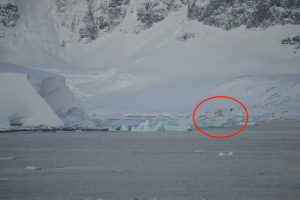
June 23 – Thursday – Slow day. I slept through breakfast. Uploaded/downloaded photos to the ship’s shared drive. Wrote some recommendation letters and emails and read.
June 24 – Friday – 2nd day in the Drake Passage, which has been relatively calm heading home. We are about halfway to the Straits of Magellan – Argentina side this time – less scenic but a half day shorter.
June 25 – Saturday – 3rd day in the Drake Passage and still relatively calm heading home. Essentially all packing that we can do – short of what will be packed in dry ice for shipment to Philadelphia – is complete. Mostly reading, planning who will write up the research. Played some cribbage.
June 26 – Sunday – We docked in Punta Arenas in the early afternoon and were greeted by a rainbow over the harbor. Most of our group stayed on the ship overnight, but we had a group dinner with scientists and some crew at a restaurant onshore. Lamb as the specialty, and though not exactly what I was craving, getting reservations for this many people limited us. Most of us headed back to our bunks on the ship, but a couple of the younger members of the group went on for most of the night.
June 27 – Monday – Today we packed our boxes of frozen materials (slides, DNA samples, chlorophyll samples) which took several hours. Then we checked into a nice hotel – Cabo de Hornos – ate some dinner there and then our team went out to a couple of different bars where we bumped into others from the cruise. Walked home and to bed relatively early.
June 28 – Tuesday – We went out to breakfast as a team (Temple and WHOI participants, since the Florida contingent flew out yesterday). Then we walked around, popping into a few shops to get last minute gifts. We flew out of Punta Arenas to Santiago, Chile in mid-afternoon. After several hours of layover we went on overnight to . . .
. . . June 29 – Wednesday – Atlanta, Georgia for Customs and then after another layover it was on to Philadelphia and a train ride home to my neighborhood. Exhausted, but happy to see Elizabeth and our dog Chase who picked me up at the regional rail station.
2. Images and info from an earlier expedition (October/November/December 2019; NBP 19-10) west of the Antarctic peninsula aboard the Nathaniel B. Palmer.
Unlike the earlier expedition as part of our grant on the USIB Laurence M. Gould (see #3 below), I was able to make this cruise and the CTD worked! There were some lost science days with thick ice and a call back from our southernmost station to participate in an emergency evacuation between the U.S. Palmer Station to the Chilean Frei Station for a flight for a patient to Punta Arenas. Although our goal to revisit and secure comparative data from the 13 stations from the LMG 19-04 was not achieved, it was overall quite a success. The first paper published from this expedition was a bit delayed because of the covid pandemic, but is out just recently (Grattepanche, J.-D., W.J. Jeffrey, R.J. Gast, R.W. Sanders. 2022. Diversity of microbial eukaryotes along the West Antarctic peninsula in austral spring. Frontiers in Microbiology [doi:10.3389/fmicb.2022.844856]).
Views of bergs and shoreline from NBP 19-10 in November/December 2019
Penguins, Whales, Seals
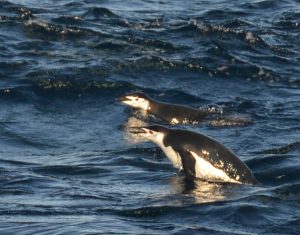
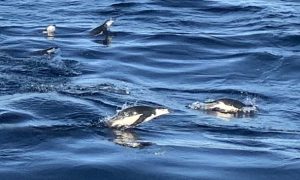
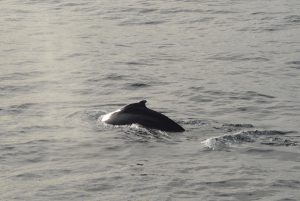
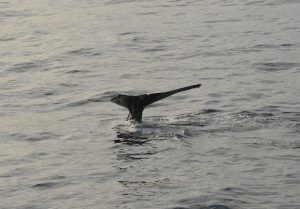
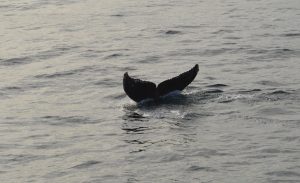
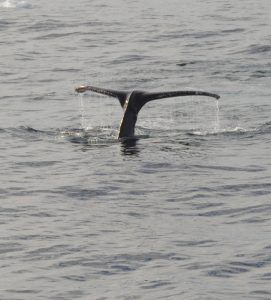
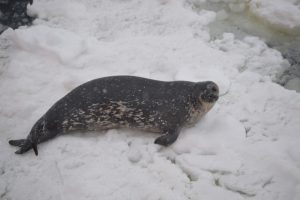 People
People
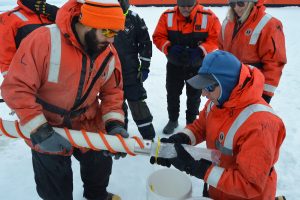 Chris and Jay Diii with an ice core.
Chris and Jay Diii with an ice core.
3. Images and info from an April/May 2019 (LMG 19-04) research cruise west of the Antarctic peninsula aboard the Laurence M. Gould
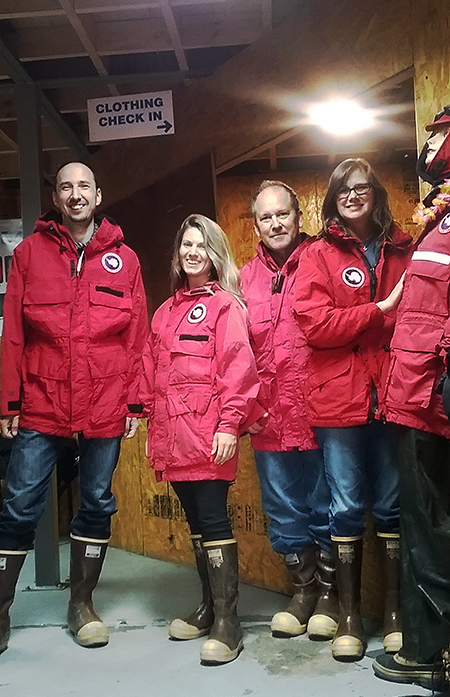
I was scheduled to be on the Gould for LMG19-04 (April 10 – May 28) for my 5th Antarctic trip, but at the last minute was unable to travel. The team, however, was able to set up and left Punta Arenas, Chile on April 12, 2019. The rest of the team consists of (L-toR) Jean-David [Jay Diii] Grattepanche (Temple), Ari Simmering (University of West Florida), Wade Jeffrey (University of West Florida) and Rebecca Gast (WHOI).The dummy on right is not part of the team.
Oceanographers seem to love acronyms and often give a cruise or a series of cruises a name. Our team’s is moniker is REMIXED which stands for Research Examining MIXotrophic Ecology and Diversity.
What is it we’re doing and why are we interested? Traditionally, microbial eukaryotes (algae and protists – not bacteria) are considered either phototrophic (use sunlight to grow) or heterotrophic (eat prey to grow). Mixotrophy refers to an organism’s ability to utilize a combination of these trophic strategies. We are specifically interested in the micro-algae that are able to eat prey. They are not unique to the Antarctic, but this alternative nutritional strategy may help them survive several months of darkness in the polar winter. We’ve found them at both poles (and lakes and tropical oceans). You can follow the team’s experiences on Becky’s blog of the trip. Here’s a link to her first post: https://www2.whoi.edu/staff/rgast/2019/04/14/
I’ve stolen these pics from her to post here. 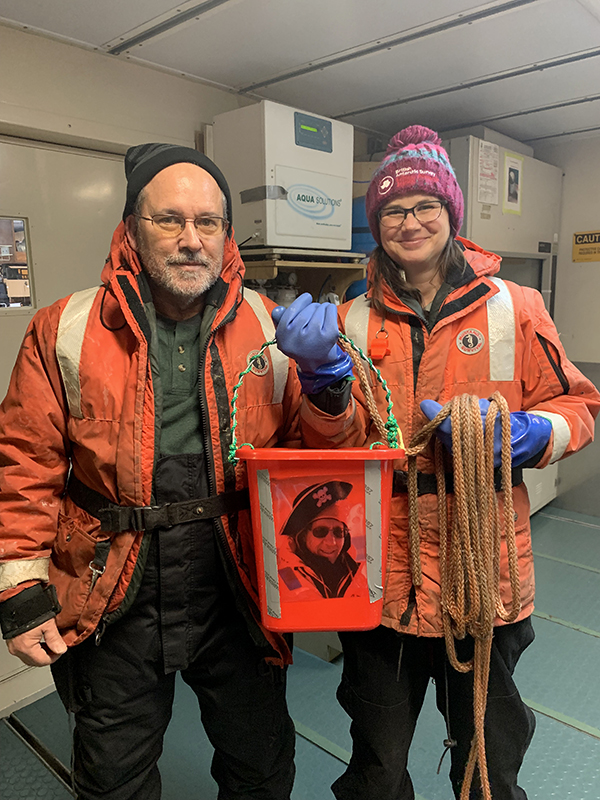
The CTD, used to collect water from depth had issues, so they used backups – buckets named “Bob” – to put me in the cold with them (at least symbolically).
4. More images and info from research cruises in the Ross Sea (Antarctica) aboard the Nathaniel B. Palmer
I participated in four cruises in the Ross Sea, Antarctica working with Rebecca Gast (Woods Hole Oceanographic Institution) and David Caron (University of Southern California, formerly at WHOI). In December/January 1998/1999, I helped isolate protists and bring them into culture to establish a culture collection of protists from an extreme environment. This collection of protists, with additions of species from our other cruises, has been maintained at WHOI, USC and Temple University. When we went again in October/November 2003, the N.B. Palmer lost 2 of its 4 engines and we were forced to turn back before reaching our target area of research – the ice-free region (the polynya) that develops in the southern Ross Sea each October/November in an otherwise ice-covered ocean. We were able to run a side experiment examining the sensitivity of the heterotrophic flagellate, Paraphysomonas, to UV radiation – but never published the results. For a web page related to the second cruise try this link. In 2005, we were once again aboard the Palmer for a cruise to the polynya. At that time, I teamed with Steffi Moorthi to survey several stations for the presence of mixotrophic flagellates in the Ross Sea. We found mixotrophic protists, which have chloroplasts (are photosynthetic) and ingest bacteria in varying proportions at every station. These included communities in open water, water under ice, and in cores from pack ice (Moorthi, Caron, Gast & Sanders. 2009. AME 54:269-277). In January 2011, we returned to investigate mixotrophy once again – keep an eye out for updates of the research from that cruise – including publications (Gast, R.J., S.A. Fay and R.W. Sanders. 2018. Mixotrophic activity and diversity of Antarctic marine protists in austral summer. Frontiers in Marine Science 5:13; Gast, R.J., Z.M. McKie-Krisberg, S.A. Fay, J.R. Rose, and R.W. Sanders. 2014. Antarctic mixotrophic protist abundances by microscopy and molecular methods. FEMS Microbiology Ecology 89:388-401) and also from our 2009 Cruise to the Arctic Ocean (Sanders & Gast. 2012. FEMS Microbiology Ecology 82:242-253).
Photos below are from December 1998 – February 1999 (NBP 99-01)
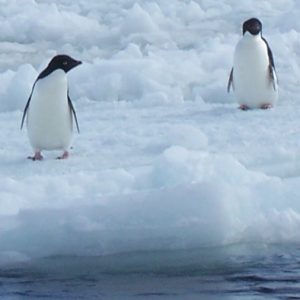 Adéle penguins Adéle penguins |
|||
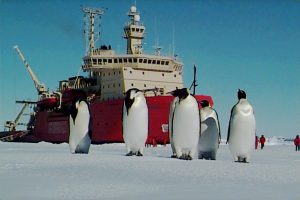 |
|||
| Emperor Penguins with the RV/IB N.B. Palmer. Photo by R. Sanders ©1999 |
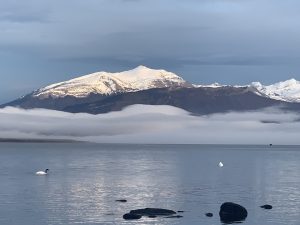
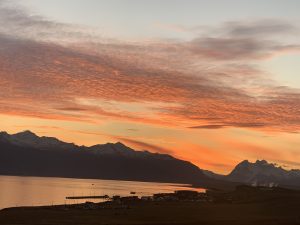
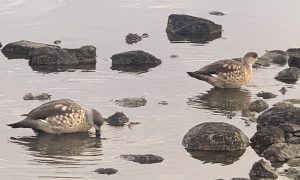
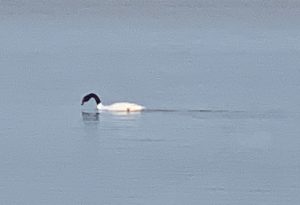
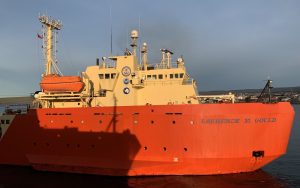
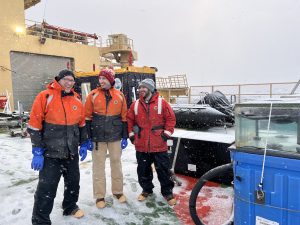 (left) Bob, JayDiii and Chris on the helo (helicopter) deck. That’s one of our flow through seawater tanks on the right and snow on deck.
(left) Bob, JayDiii and Chris on the helo (helicopter) deck. That’s one of our flow through seawater tanks on the right and snow on deck.